Today hardly anyone could forget yesterday
Memories take a more solid form for Australians in 1788. In fact today hardly anyone could forget yesterday. Newly landed settlers can not be bothered to spend the energy in having to re-establish their social identity in Australia. They go about merely trying to convince people of their past proven trustworthiness and charm rather than actually demonstrating it.
Dean Wallis manages his own board of testimonials clearly written for all to see, but only from the vantage point of the ocean – Europe (yesterday). Countess Beckendorff of Berlin writes “Mr Wallis proved to be most enjoyable company at parties which I attended”. W Dawson-Smith of Forthampton House writes “Mr Wallis was regarded as one of the most desirable and fashionable men of our social group”.
In England in 1788 there were no police. Everybody wanted police but the French had already thought of it and the British Parliament could not bear to be seen to be copying the French. As a result British citizens had to catch those that had stolen from them, collect the evidence against them and then try them in court. A baker who had a dollar’s worth of bread stolen from him could spend up to a week getting justice. More energy was expended in pursuing the past rather than living in the present.
In Australia the transported British legal system perpetuates a need for punishment for personal pain where victims tirelessly pursue their offender. Malnourished settlers chase a mobile court of law encircled with hanging convicts in order to throw their vegetables at them. People busily hang their perceived wrongdoers up everywhere. In Australia in 1788 wood meant for the foundations of buildings were being used to make gallows.
Cameron Hayes: “This is about a world of people who could not deal with things present without using the past to contextualize them.
When the Whites first came to Australia, they couldn’t be bothered having to re-establish their position, character, or personality all over again as they had done in England.
So most of them spent their energy convincing people that they were really charming back home rather than having to start being charming all over again here.
Most new Australians carried testimonials from people back in England, saying that they were really funny and charming, that they were the life of many parties back home, and should automatically be regarded as desirable company by anyone who meets them in Australia.”
The Approach to Cameron Hayes – 14 Kurdish refugees…
here is an article my friend wrote about my Milikapiti works. the show is on at Dark Horse Experiment at 110 franklin st in Melbourne from 1st august until september 2.
this is the article here – ARTICLE
this is a painting from the show.
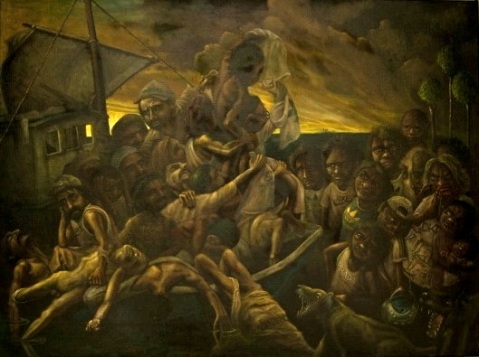
14 Kurdish refugees land in Milikapiti and ask, “is this Australia?” – 4th November 2003, 2012, oil on linen, 61 x 81 cm
on the 4th. of november 2003 14 kurdish refugees landed on the beach at milikapiti. one of the kurds yelled out from the boat ‘IS THIS AUSTRALIA ‘. the tiwis on the shore were not sure because the australian government was disowning the bits of itself that could be used to help people like the refugees.
this is an article from SMH about this story
Quote from marielle’s article about this work:
“The latter work referencing the sinister use of marketing in politics and the media. Based on a true story, a group of refugees were spotted on a vessel in the bay at Milikapiti. The conservative Howard Government of the time did a fantastic job of instilling a fear and hatred campaign of refugees through the media, basically branding them as potential terrorists and possible carriers of unknown diseases. It worked. So pervasive was this strategic political message that it even reached across the nation from capital cities to remote small communities. So here we have asylum seekers in the guise of The Raft of the Medusa, instead of ragged cloth they are waving brand name t-shirts representing our new dominant culture – the well marketed Brand. Would they have more success by appealing, not to empathetic fellow people, not to other displaced victims, but to those who like the same brands – who do you identify with? Are you Nike or more of a Burberry? Are you Apple or PC? Are you Right or Left?”
Mathias Ulungura captures Hajime Toyashima – 19th February 1942
“The first prisoner of war captured on Australian territory was Hajime Toyashima, who crash-landed on the Tiwi Islands on the way home from bombing Darwin. He staggered to the beach where he saw lots of Tiwi women out crabbing in low tide. Hajime grabbed one of the babies left on the dry sand as a hostage. The Tiwi women just thought he was offering to carry the baby, so they returned to the community with Hajime following behind them, yelling in Japanese with a gun to the baby’s head.
When Hajime started to hear the Tiwi men, he handed the baby back to the grateful Tiwi women and ran off. Eventually he was caught by Matthias Ulungara who, before delivering him to the Whites, toured him around all the communities.
Tiwis only get bits and pieces of White culture, phrases that fall from the sky, like the leader of the tough gang who irons his Celine Dion tour T-shirt, or when a friend visited me from Germany, an old Tiwi woman wished her good luck and, “Heil, Hitler”.”
The link below takes you to an article about this true story. The first prisoner of war in Australia during WWII was captured on Melville Island by Mathias Ulungura. Click here to read the article by Catherine Schwerin.
dog torturers ?
here is another article about my show coming up in august. this is the link http://www.aboriginalartnews.com.au/2012/06/exhibition-cancelled-after-tiwi-protest.php
another outrage
An article about the forthcoming show from artinfo.com
Perhaps you can now find the article by clicking ON THIS LINK The article is called Why Artist Cameron Hayes Was Censored: Depictions of Aboriginal Life by White Artist Spark Outrage and it is written by Nicholas Forrest.
The Cambridge nursing home won the freeway mural project
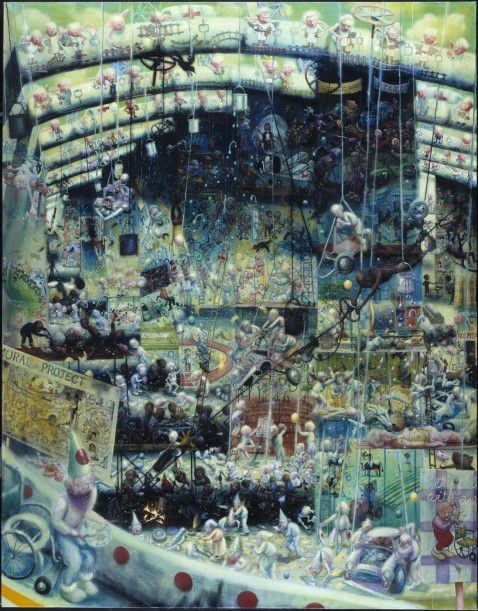
The Cambridge nursing home won the freeway mural project by Cameron Hayes. 2001-2, oil and glitter on linen, 84 x 66 inches.
The local government wanted to have a mural painted on the massive columns which hold up their new freeway. The Cambridge nursing home won the freeway mural project through their winning tender. Each resident was assigned an area of column whose image would link up with the area next to them to form one picture.
Each retiree planned only their own personal sections and started making their art without consulting one another. Despite their age it didn’t occur to any of them that other people may not fit in with their own plans, and unexpected events may impact on their grand vision.
One artist is furious to find that his Raphael-like cherubs are going to be sullied by his neighbour’s pornographic winged women, whereas the best the guy below can think of is to just paint every woman he can still remember sleeping with.
An old man has spent the remaining time of his life making a space suit and engineering a complicated plan to travel into space only to find that his wife painted only a single propeller plane. An Indian resident has painted a pantheon of Hindu gods while his Muslim neighbour painted a cart pulled by devils leading the cart into hell.
A lot of the residents are not sure how much of their remaining time to spend on something they may not see finished or could even be painted over. They decide to live in the moment and eat the painted seeds on the mural farm, smash open the piggy banks and eat the cow’s meat rather than save it for its milk.
The senile who loiter around the bottom of the freeway have broken bits of plate hoping to catch a skerrick of the cooking cow. Others try to break in to the windowless deserted car wrecks with coat hangers that have been dumped at the bottom of the freeway desperate for a feel of the steering wheel.
At the top of the freeway everybody’s different perceptions of God makes it impossible for the angels to build a cohesive rail line to heaven.
To prove he was the only God, Caligula had all the pilots killed and still made the people take their flights

To prove he was the only God, Caligula had all the pilots killed and still made the people take their flights by Cameron Hayes. 1999, oil & glitter on linen, 60 x 72 inches.
In Ancient Rome an individual believes his own uniqueness must be elevated and recognised, and has the power to do it. The Emperor believes he is God, and to prove he was the only God, Caligula had all the pilots killed and still made the people take their flights. Not just the senators but even the army knew that Caligula had gone too far and had to be assassinated.
Caligula had already ordered that all the heads be cut off the statues of the gods and heroes in Rome and the provinces, and had them replaced with factory-produced busts of his own image. But the statue of himself he had designed for the biggest synagogue in Rome was too big, and would damage the synagogue when pushed into it. As each bureaucrat delayed the statue’s construction (knowing it would cause a public riot) they were killed.
Caligula defined God as a man who had power over every person and spent his time controlling every individual, their luck and coincidence. After Caligula had given himself everything he wanted, he then decided to tie ropes to every individual which led back to his own patio. The despot Caligula, whose personality traits have morphed him into a Mr Burns for a not so subtle contemporary personality portrait, is not limited in expression by laws or regulations but ultimately by his own lack of imagination and ability.
Cameron Hayes: “One night Caligula had a dream that he was a god. The following morning he was frustrated that nobody else had the same dream. Fortunately, Caligula had all the money and power in the world, so he was able to convince people he was a god with his display of influence on daily life, his control of luck, and his manipulation of the past and present.
What Caligula wanted most of all was to have an effect on people, be it good or bad. In pre-science Rome, Caligula knew that chance and luck played the greatest part in people’s lives, and that the older gods got all the credit for it.
Caligula knew that if he could manufacture luck and, if he could apply luck, then he would be the one god to replace the marble and bronze gods that were more famous than Caligula.”
From the air we all felt sorry for the sick and starving
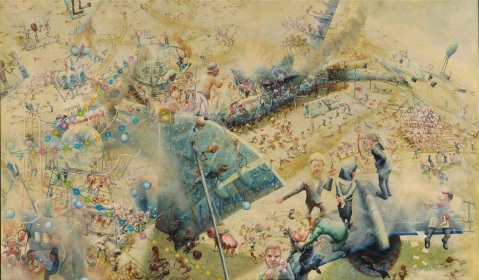
From the air we all felt sorry for the sick and starving by Cameron Hayes. 1997, oil on linen, 51 x 87 inches.
This is about a planeload of white people who were flying from Australia to Europe for their holidays. On the way to Europe, the plane flies over Africa, and everyone looking out of the windows of the plane felt sorry for the starving people, and wished they could help.
But then all of a sudden the plane crash-lands in the middle of the African desert amongst all of the starving Africans.
The people from the plane realize they have only a limited food supply on the plane and therefore realize they don’t want to share the plane’s food with the Africans.
So the Whites have to find ways not to feel bad or hypocritical about not sharing their food with the Africans.
While most of the Whites just refused to leave the plane, other Whites tried to frame the Africans as wasteful, litterbugs or having voluntary eating disorders. Soon the Whites start accusing other Whites of being racists or of exploiting the Africans so they look better in comparison.
When the Whites realize that it’s easier to feel good about yourself by accusing other people of being bad rather than actually doing good acts, then everyone starts accusing everyone else.



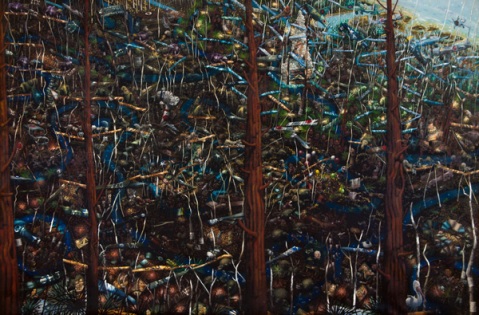
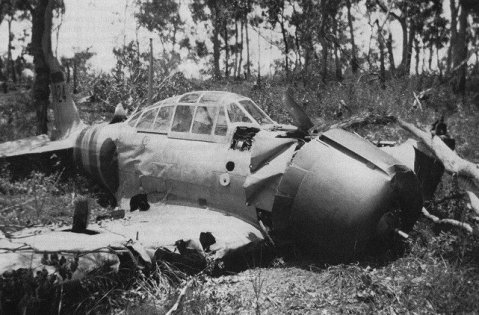






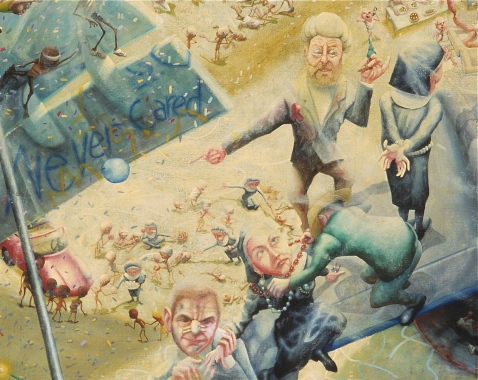
In the South Pole the explorers were so afraid of not having enough food…
In the South Pole the explorers were so afraid of not having enough food for winter that they starved to death in summer, 2001-2, oil and glitter on linen, polyptych 74 x 100 inches overall.
Polar explorers, including the famous competitors, Scott and Amundsden, would camp on the coast, and then set out on dog-powered sleds to the South Pole in spring. Many of the explorers were so terrified of being stranded inland during the Antarctic winter that they would not eat their supplies during the summer and consequently starved to death with a sled full of food. Other explorers were so aware that they depended on their dogs’ health to guarantee their return that they gave their own share of food to their dogs. Many starved and skeletal explorers were pulled by overfed, fat dogs. The South Pole from 1910 to 1920 was covered with dog shit and dead explorers.
For these polar explorers, at first summer was their favorite season, but they could not enjoy it because they knew it was all down hill from there; so spring became their favorite because it was leading up to summer. But summer had become their least favorite season so winter became their favorite because all the good seasons were to come. Although it was cold and miserable, at least they could look forward to improvement. These explorers felt it was better to always be suffering with the hope of things getting better than comfortable with the fear of things getting worse .This story is about people who use unhappiness as insurance against disappointment.
The panel on the left is of the explorer, Scott, as a young man already displaying signs of his compulsive behaviour by showing his envious sisters his uneaten Easter egg in July, though now it has turned powdery, white, flyblown and thoroughly inedible. A snowflake which has drifted across from the snowy central panel to summer, magnifies this detail. and tearfully covering his new schoolbooks on Christmas day.
The middle panel shows the South Pole, a mountain of frozen dog shit, surrounded by flags that didn’t quite make it. Young women endlessly exercise on their sleigh pulled by old fat ladies, the misery from fear of aging making the adjustment to old age more bearable and even a relief. Explorers are driven on sleighs pulled by their fears of the future. Cows, whose udders are bursting with milk, drag the coffins of their children to the pole.The final destination – the pole itself – is a flyblown mountain of dog shit, a result of misspent resources and excess energies of polar expedition.
The right hand panel shows the explorers’ funeral and finally the meeting of an older Scott and Amundsden in the frozen section of the supermarket in heaven. In the background are plump sleigh dogs that Scott would not eat to save himself. As in the race to the pole, Amundsen has arrived first. He has all the memories of his journey captured in the shiny mirrors of blocks of melting ice.
In the top panel, the cast of the story takes a bow to the applause of the seals and bouquets of frozen fish.
Detail 1
Detail 2
Detail 3. Hayes often uses photos to assist in capturing expressions and gestures. The young Scott here is based on a photo of the artist himself as a young child. The ballerinas are friends, and his sister, from different photographs of them as youngsters at ballet performances.